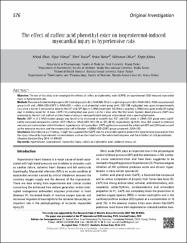| dc.contributor.author | İlhan, Selçuk | |
| dc.contributor.author | Yılmaz, Nigar | |
| dc.contributor.author | Nacar, Emel | |
| dc.contributor.author | Motor, Sedat | |
| dc.contributor.author | Oktar, Süleyman | |
| dc.contributor.author | Şahna, Engin | |
| dc.date.accessioned | 2020-11-20T16:17:46Z | |
| dc.date.available | 2020-11-20T16:17:46Z | |
| dc.date.issued | 2014 | |
| dc.identifier.issn | 2149-2263 | |
| dc.identifier.issn | 2149-2271 | |
| dc.identifier.uri | https://doi.org/10.5152/akd.2014.4825 | |
| dc.identifier.uri | https://hdl.handle.net/20.500.12809/3360 | |
| dc.description | WOS: 000346136500005 | en_US |
| dc.description | PubMed ID: 25036319 | en_US |
| dc.description.abstract | Objective: The aim of this study is to investigate the effects of caffeic acid phenethyl ester (CAPE) on isoproterenol (ISO)-induced myocardial injury in hypertensive rats. Methods: Rats were divided into 4 groups (n=29): Control group (n=8), L-NNA (NG-Nitro-L-arginine) group (n=8), L-NNA+ISO (L-NNA+ isoproterenol) group (n=7) and L-NNA ISO+CAPE (L-NNA+ISO+caffeic acid phenethyl ester) group (n=6). ISO (150 mg/kg/day) was given intraperitoneally (i.p.) once a day for 2 consecutive days (at the 12th and 13th days of L-NNA treatment). NG-Nitro-L-arginine (L-NNA) was given orally (25 mg/kg/day) in drinking water for 14 days. CAPE (10 mu mol/kg/day) was given (i.p.) for 7 days after the first week. Systolic blood pressure (SBP) was evaluated by the tail-cuff method and biochemical analysis were performed using an autoanalyzer and a spectrophotometer. Results: SBP in all L-NNA-treated groups was found to be increased at seventh day. AST and LDH levels in LNNA+ ISO group were significantly increased compared to control (AST: 125 +/- 5 vs. 105 +/- 2; LDH: 861 +/- 154 vs. 571 +/- 46 U/L respectively) (p<0.05). Also, ISO caused to extensive necrosis and mononuclear cell infiltration in hypertensive rat myocardium. CAPE application reversed the enhanced AST and LDH levels as well as the extensive necrosis and the mononuclear cell infiltration in LNNA+ISO+CAPE group compared LNNA+ISO. Conclusion: According to our findings, it might be suggested that CAPE may be a favorable agent to protect the hypertensive myocardium from the injury induced by isoproterenol via mechanisms such as the induction of the antioxidant enzymes and the inhibition of lipid peroxidation. | en_US |
| dc.description.sponsorship | Research Fund of Mustafa Kemal UniversityMustafa Kemal University [1003M0103] | en_US |
| dc.description.sponsorship | This study was supported by The Research Fund of Mustafa Kemal University (1003M0103). | en_US |
| dc.item-language.iso | eng | en_US |
| dc.publisher | Turkish Soc Cardiology | en_US |
| dc.item-rights | info:eu-repo/semantics/openAccess | en_US |
| dc.subject | Hypertension | en_US |
| dc.subject | Isoproterenol | en_US |
| dc.subject | Myocardial Injury | en_US |
| dc.subject | Caffeic Acid Phenethyl Ester | en_US |
| dc.subject | Oxidative Stress | en_US |
| dc.subject | Rat | en_US |
| dc.title | The effect of caffeic acid phenethyl ester on isoproterenol-induced myocardial injury in hypertensive rats | en_US |
| dc.item-type | article | en_US |
| dc.contributor.department | MÜ, Tıp Fakültesi, Temel Tıp bilimleri Bölümü | en_US |
| dc.contributor.institutionauthor | İlhan, Selçuk | |
| dc.contributor.institutionauthor | Yılmaz, Nigar | |
| dc.identifier.doi | 10.5152/akd.2014.4825 | |
| dc.identifier.volume | 14 | en_US |
| dc.identifier.issue | 7 | en_US |
| dc.identifier.startpage | 576 | en_US |
| dc.identifier.endpage | 582 | en_US |
| dc.relation.journal | Anatolian Journal of Cardiology | en_US |
| dc.relation.publicationcategory | Makale - Uluslararası Hakemli Dergi - Kurum Öğretim Elemanı | en_US |


















